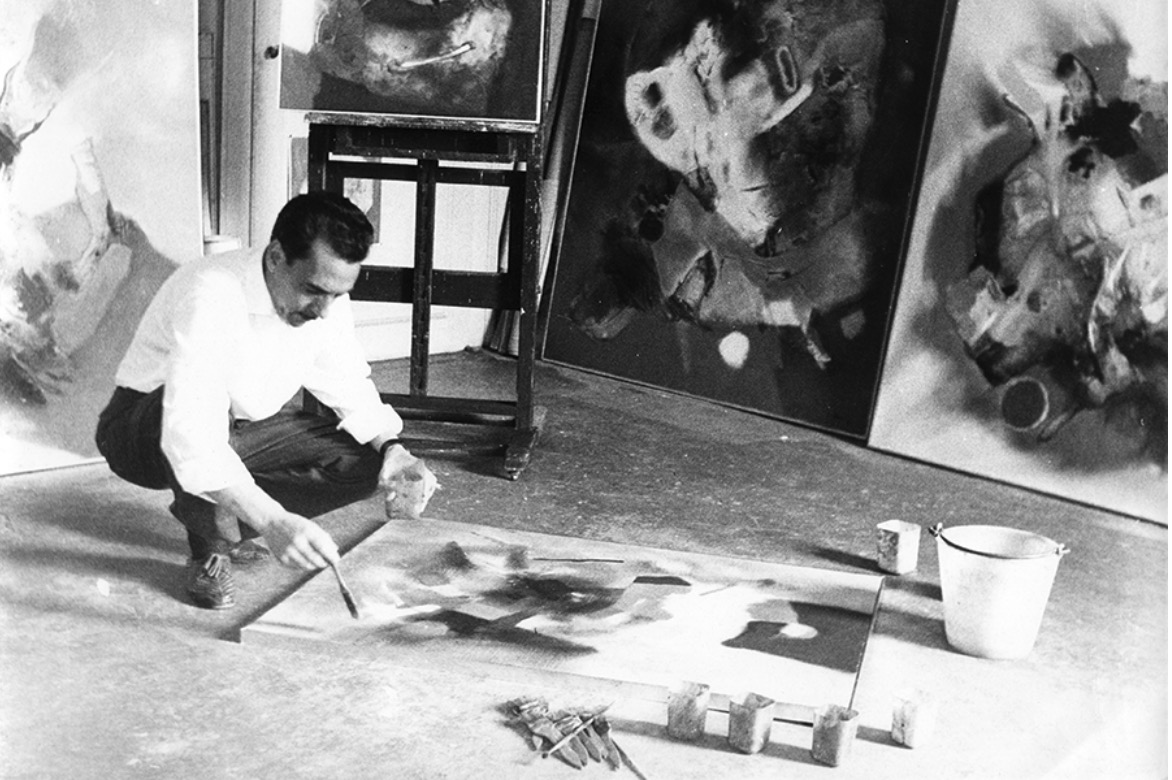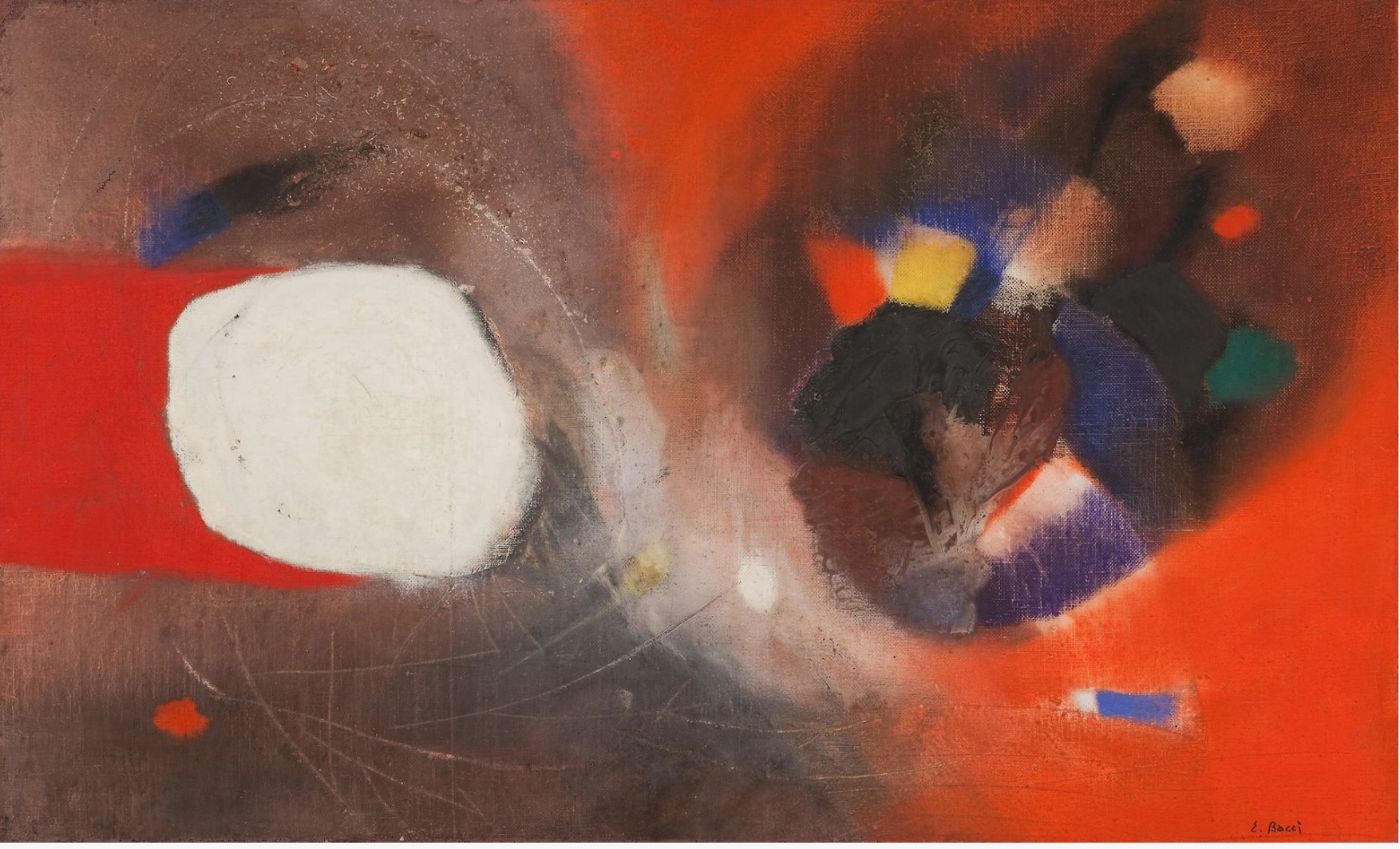Comments
ART WATCH - Edmondo Bacci: Energy and Light, curated by Chiara Bertola, and currently on view at the Peggy Guggenheim Collection in Venice, is the first retrospective of the artist in several decades. Bacci was a native of Venice, a city with a long and illustrious history of painting, going back to Giorgione and Titian, Veronese and Tiepolo. As a painter, he was thoroughly immersed in this great past – as an artist he was determined to transform and remake that tradition in the face of modernity and its vicissitudes, what he called “the expressive crisis of our time.” That he has slipped into obscurity affords us, at the very least, an opportunity to see Bacci’s work essentially for the first time, without the burden of over-determined interpretations or categories.

Almost from the beginning, Bacci seems to be rebelling against tradition, “breaking free from the traditional colorism recurrent in Venetian painting.” It is notable, for example, that Venetian painting is generally regarded as giving priority to color over line, for Bacci begins by effectively bracketing color altogether, taking his cue instead from the post-war industrial landscape of Marghera, with its wilderness of pipes, tanks, towers, smokestacks, and cranes. With masterful chiaroscuro, his ‘Fabriche’ employ crisscrossing black lines of varied length, thickness, and tonality, in the search for a “new way to construct space.” These pieces are the scaffolding with which Bacci will construct his logos of light and color, his presentation of Being as a happening, an event, an esplosione. Allowing his work to develop immanently in and through its own inherent logic, eventually he comes to add color to the Fabriche while retaining the explicit linear structure. Gradually the scaffold recedes to the point where it is merely implicit, a kind of painterly presupposition. As his work develops, color is able to assume the functions of drawing.
Bacci’s work manifests an immense energy, an explosive presence, described by one critic as “cosmic magma.” In Avenimento #12 (1955) and Avenimento #15 (1956), for example, there is certainly a volcanic fury to his use of molten-like red and orange. One might be tempted to say that Bacci is a cosmological painter, but that is misleading if we take it to mean he is rendering images of the cosmos, and cosmic phenomena – although paintings such as Alba (1954) and Piccolo Alba (1954), among others, do indeed evoke the immense spread of strange galaxies across the unfathomable reaches of space. What Bacci is doing is something which painting alone is in a position to do, and that is first, to take the stuff, the inanimate material of paint and magically endow it with life, so that it seems to shine forth with its own imminent storehouse of energy. Bacci is able to make his colors (predominantly blues and reds) glow and smolder with a living heat, as if the painting were lit from behind.

Yet there is also no doubt Bacci is concerned with space and with depth, although not in the sense of merely producing the illusion of depth on a two-dimensional surface. Bacci was a member of the Spazialismo movement, and for him space is a riddle that goes to very heart of being. His work represents an approach that radically breaks with thinking about depth at least since the Renaissance and Descartes. The typical thinking is that we don’t perceive depth as such, but only infer it from signs, that it is ultimately derivative from height and width. Bacci creates distance without needing recourse to illusionism or traditional techniques of perspective. He is not interested in creating the semblance of depth; but in laying bear how depth is already a part of our vision, our pure experience of light and color.
The traditional approach is premised on a disembodied view of vision, as if seeing were a purely mental activity, the scrutiny of a disembodied mind. With Bacci, sight becomes “the most wonderful odyssey of the enchanted and enchanting eyes of the spirit, an odyssey of vision,” to quote Toni Toniato, one of the foremost experts on Bacci. The invocation of ‘odyssey’ is exactly right, inasmuch as an odyssey is about homecoming: Bacci’s paintings are about restoring the sense in which vision is internally related to the world. Vision is not merely the way in which we see the world, but the way in which Being folds back on and interrogates itself. Depth, space, and voluminosity become the way in which Being discovers and accesses itself through the painterly act of seeing. Depth is not an abstraction for Bacci, but something profoundly sensuous, and always already manifest chromatically.
Both in terms of color and depth Bacci represents an orientation that is radically at odds with Cartesianism, according to which color is a mere secondary quality, not a real property of things as such. For Bacci, color is the ‘primary element,’ substantial, real, and voluminous: it has depth, and weight, and manifests the actual substance of the world. Color is there at the very coming-into-existence of the world, ‘the form that matter connotes as it becomes visible’: this is indeed the primordial avenimento or event to which Bacci keeps returning, the primeval event from which time itself, the durational world is brought forth. For Bacci, just as vision cannot be disembodied, neither can the world (depth, color) be de-substantialized: it is a voluminous and chromatic world that wants to appear, not simply to us, but to itself. Depth and color are a kind of theophany, an appearance of the divine. The ontological task of the painter is to transcribe the way in which Being comes to appear to itself. As Toniato points out, Bacci’s vision is an essentially pantheistic one, where the world of nature and the divine ultimately constitute one reality.
These paintings are incredibly sensuous: the colors are intense, vibrant, and alive, generating varied textures, masses, and modes of trajectory; that is, Bacci’s colors are not static – they constantly move, and migrate at differing velocities. The finest Avenimenti do something that painting has, not always consciously, strived to accomplish but rarely if ever achieved: namely, to let color itself describe and configure the origin of a world out of which sense can be derived. Color is not a primary quality (let alone a secondary quality) of things – it is not merely a property of things (as it is in ordinary perception, where color is not perceived for itself); it is the thing in Bacci’s work, an autonomous substance. Red is an irreducible force in and of itself. Bacci’s achievement consists in realizing the full emancipation of color: his incandescent chromatics free color from any subservience to objects, so that it can finally and truly come into its own.
Bacci will continue to experiment in the quasi-cartographical works of the late 1960s and early 1970s, including those where he makes use of unusual materials, such as burnt paper. Bacci’s map-like images can incorporate diagrammatic features, such as segmented lines, and the extensive use of pinpoints, or dots of varying size, distribution, and density. His proximity to technical charts and imaging can be seen as representative of Spazialismo with its attention to contemporary science and technology. The later works are another indication of Bacci’s metaphysical probing: Bacci is interested in what I would call productive constellations, the world as a sending forth of terrains, with varied topographies, and heterogenous regions. For Bacci, an avenimento is a kind of dehiscence, a deflagration which did not simply occur long ago in some abysmal past: it is the event which continues to unfold at every moment, the event which makes a world, a cosmos possible at all. It is the event which makes a subject possible. In short, we are the offspring of these massive eruptions, these great dispersals of energy of which Bacci is an unparalleled master.
(Sam Ben-Meir is an assistant adjunct professor of philosophy at City University of New York, College of Technology.)






